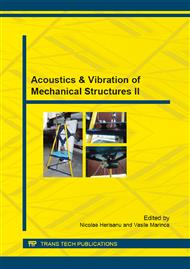p.115
p.122
p.129
p.136
p.142
p.148
p.154
p.159
p.165
Damage-Caused Frequency Shifts in Beams and their Use in Structural Health Assessment
Abstract:
Transverse cracks affect the stiffness and consequently the dynamic behavior of beams, by altering the natural frequencies. Actual cracked beam models are not able to explain in-deep the vibration mechanism and, therefore, no mathematical relation able to predict frequency changes due to damage exist. This paper proposes a new damage model which better explain the dynamic behavior of beams with open and closed cracks and a mathematical relation able to predict the frequency changes due to damage. In contrast to actual models, a global approach is used, by considering the influence of the stored energy distribution for each transversal vibration mode. Since the energy loss globally quantifies the state change due to damage, it was possible to replace the cracked beam with an equivalent one having constant but reduced stiffness. Based on it, a relation indicating the frequency drop damage was contrived and tested, by means of the finite element analysis, for various damage types and locations along the beam. Simulations have shown that accurate prediction about the natural frequency shifts can be made with the proposed relation.
Info:
Periodical:
Pages:
142-147
Citation:
Online since:
October 2015
Price:
Сopyright:
© 2015 Trans Tech Publications Ltd. All Rights Reserved
Share:
Citation:


